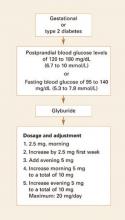Gestational diabetes and oral hypoglycemic agents: A fresh look at the safety profile
Although insulin has been the treatment of choice when dietary measures fail, oral hypoglycemic drugs are increasingly recognized as safe and effective.
Even on oral therapy, a small number of women do not attain desired levels of glucose control. For these patients, combination therapy (eg, insulin secretagogues with antihyperglycemic agents that act to improve insulin sensitivity) or insulin therapy should be substituted (TABLE 3). This approach should prevent overtreatment and unnecessary inconvenience for the patient.23-25
FIGURE Medical therapy decision path
TABLE 3
Treatment plan for gestational and type 2 diabetes
| STAGE OF THERAPY | INDICATIONS | DECREASE IN HBA1C |
|---|---|---|
| Medical nutrition |
| ~1% |
| Oral therapy: glyburide and/or metformin |
| ~2% |
| Insulin |
| ≥4% |
| HbA1c = glycosylated hemoglobin A1c | ||
Dr. Langer reports no financial relationship with any companies whose products are mentioned in this article.







